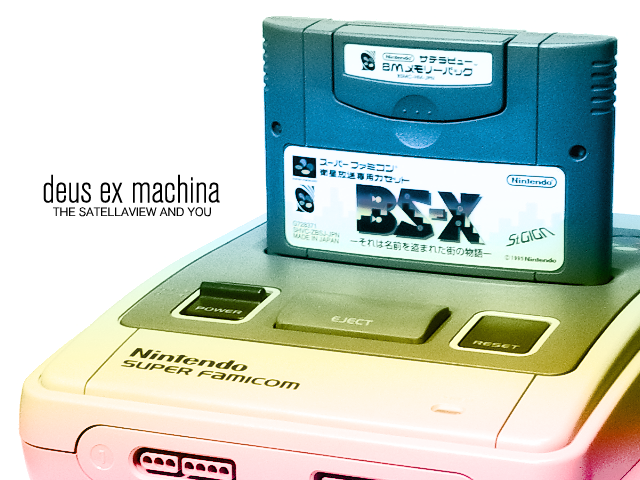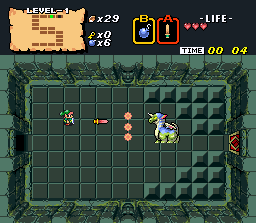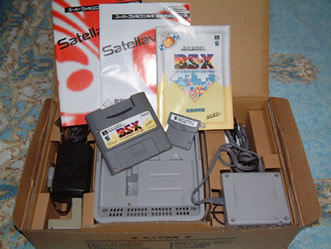
Who remembers the Satellaview? Once upon a time in the 90’s (of course), Nintendo forged a pact with the first private satellite broadcasting television station in Japan, WOWOW. With its Hiroshi Yamauchi-fueled benevolence, Nintendo bestowed upon WOWOW’s satellite radio-based daughter, St.GIGA, the power to use its satellites to daringly shoot out signals (beautiful signals!) full of video games, aimed at the young and old who just so happened to have a Super Famicom and a Broadcast Satellite (BS) tuner for their television– which, of course, could be easily purchased at your nearest St.GIGA-sponsored electronics store. It was a true partnership for the ages, and though many a parent may have wondered if Nintendo really was just sending signals full of video games and not also subliminal messages, Nintendo likely satiated them quickly with the newfangled games of the time.
And what vainglorious times they were! With games like the BS The Legend of Zelda trilogy (complete with fully voiced parts for Princess Zelda, the Old Man who gives Link his sword, and Ganon– that’s right, be jealous) or the pair of BS F-Zero games that remixed and expanded the original F-Zero, or even the visual novel Radical Dreamers: The Unstealable Jewel, otherwise known as either a side story of Chrono Trigger or a prequel to Chrono Cross, Nintendo’s offerings seemed nigh divine. It was as though Nintendo was the One True God, sending down angels in the forms of Link and Captain Falcon to delve into our own pitiful human existences. Sometimes, if Nintendo felt whimsical enough, it would even allow its believers to save these games onto 8-Megabit Memory Paks, lest the games be lost into the ether forever. And so as the children of Satellaview offered their willing minds in sacrifice, the Broadcast Satellite blessed them with video game-filled radio signals. And it was good.
 For half a decade– five wondrous years– the children of Satellaview received signals like manna, often gorging themselves on not merely video games (how uncouth that would be!), but magazines (Game Tiger Super Sleeper, Nintendo Power, and Monthly Coin Toss: Pokémon Cards Magazine among the most popular) and add-ons (expansions for RPG Maker 2 and character profiles/a sound gallery for Chrono Trigger). Somehow, even though the Satellaview required a subscription to the St.GIGA satellite radio station (as well as all the other stuff believers needed), users continued signing on to take quizzes and take part in contests, hoping to win a prize (telephone cards, anyone? what about Bemani Pocket games?). Meanwhile, St.GIGA broadcast data for games like the aforementioned BS The Legend of Zelda games, which consisted of fully voice-acted, separately illustrated cut-scenes– these must have made the children of Satellaview giddy beyond belief, because they continued releasing data until 1999, when the Nintendo 64 had already been in stores for three years and The Legend of Zelda: Ocarina of Time had arrived a whole year prior. Against the titans of the new age, the Super Famicom add-on that was the Satellaview seems dated in comparison– but only in retrospect. Nintendo, for its part, somehow managed to make it seem even more futuristic than its competitors.
For half a decade– five wondrous years– the children of Satellaview received signals like manna, often gorging themselves on not merely video games (how uncouth that would be!), but magazines (Game Tiger Super Sleeper, Nintendo Power, and Monthly Coin Toss: Pokémon Cards Magazine among the most popular) and add-ons (expansions for RPG Maker 2 and character profiles/a sound gallery for Chrono Trigger). Somehow, even though the Satellaview required a subscription to the St.GIGA satellite radio station (as well as all the other stuff believers needed), users continued signing on to take quizzes and take part in contests, hoping to win a prize (telephone cards, anyone? what about Bemani Pocket games?). Meanwhile, St.GIGA broadcast data for games like the aforementioned BS The Legend of Zelda games, which consisted of fully voice-acted, separately illustrated cut-scenes– these must have made the children of Satellaview giddy beyond belief, because they continued releasing data until 1999, when the Nintendo 64 had already been in stores for three years and The Legend of Zelda: Ocarina of Time had arrived a whole year prior. Against the titans of the new age, the Super Famicom add-on that was the Satellaview seems dated in comparison– but only in retrospect. Nintendo, for its part, somehow managed to make it seem even more futuristic than its competitors.
But all things must end, and Satellaview was no exception. After all, it was no perfect god. It was not accessible just anytime, for one– no, St.GIGA was a fickle benefactor, and only released content from 4:00pm to 7:00pm. Meanwhile, while some games were playable by saving them onto Memory Paks, most were not, and were only playable during that same evening timeframe. Presumably many believers turned away once they realized they could not go to work and play video games at the same time, or go for a night on the town without worrying whether they were missing something really special. Those voice-acted cutscenes in BS The Legend of Zelda, for instance? Only viewable from 4:00pm to 7:00pm– not to mention the games themselves were split up into several smaller parts, and if the BS faithful missed the timeframe, St.GIGA turned them away, telling them to try again next month. That is, assuming they would even broadcast the same data again. Often they didn’t– and the faithful would have to live the rest of their lives knowing they would never be able to play such-and-such game in its original form again. Before long, on June 30, 2000, St.GIGA turned off its signals with creamy video game filling forever, and what believers remained had to move on.
It’s interesting to wonder what might have happened in the following years, had Nintendo considered returning to its Satellaview times. Certainly, things might be a lot different– while Satellaview was only released and supported in Japan (even with the software, players needed a subscription to St.GIGA, after all), it remains Nintendo’s first attempt at what we now call digital distribution (unless we’re counting the dissemination of Famicom Disk System games) and the precursor to the modern WiiWare and DSiWare online storefronts. And while it wasn’t an online system and was very much flawed, the Satellaview’s timely (if poorly timed) broadcasts under a paid subscription seem a primitive inspiration for the Xbox 360’s Xbox Live and Xbox Live Arcade, or even Valve’s PC digital distribution service, Steam. To its credit, Nintendo did try to repeat its success with WiiWare and DSiWare, but its draconian restrictions on game size stopped games like Super Meat Boy in their tracks, sending them off to Microsoft instead– and Nintendo’s poor track record for releasing new, quality titles for the Virtual Console every week is almost as bad as the broadcasting system for the Satellaview.
Still, nobody can say Nintendo did not utilize the technology of the Satellaview era to great effect. This is a system that lasted through the Super Famicom cycle, and through much of the Nintendo 64’s, despite advances made by both Nintendo and companies like Sony and Sega. And while its influence may seem limited to Japan at first glance, consider that much of Microsoft’s success with the Xbox has been with its online multiplayer and distribution infrastructure, and realize this: the Satellaview may be a dead god, but its divine reach remains. It’s up to Nintendo to remember just how it succeeded.




 ShareThis
ShareThis








It’s kind of cool to remember tech like this and imagine how awesome that would be to run to the nes and download new and different software.
I did a video about this on youtube and that Nintendo should seriously consider remaking some of these games for Wiiware/DSiware
http://www.youtube.com/watch?v=zx8acSPzb0A
Great article, the text is *almost* as snazzy as that masthead, Mr. Hsieh. Rather fascinating, especially my knowledge of the Satellaview is vrey limited, but trust Nintendo to use ground breaking technology in the most restricting and Draconian way possible.
Sometimes it does feel like Nintendo is more interested in controlling its properties rather than spreading them to as a wide a market as possible. Or may I’m just a hippie gamer.